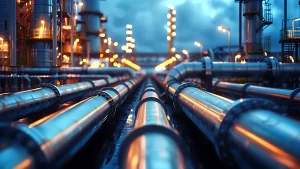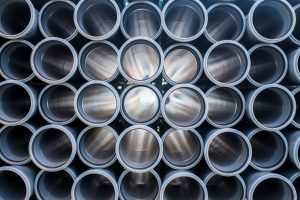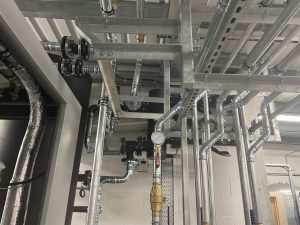In the realm of commercial pipework, the materials chosen for any given application are as critical as the design and installation process itself. The selection of piping material is a complex decision influenced by factors such as the fluid being transported, environmental conditions, budget, and regulatory requirements. In this article, we explore the characteristics, common uses, and benefits of various pipework materials in the commercial sector, covering steel and stainless steel, copper, PVC and CPVC, PEX, and HDPE.
Steel and Stainless Steel
Applications
Steel pipes, particularly stainless steel, are stalwarts in commercial pipework, offering robustness and versatility. They are widely used for their strength and durability in high-pressure and high-temperature environments. Stainless steel pipes are prevalent in carrying water, gas, and steam, making them ideal for plumbing, heating, and industrial applications.
Benefits
The foremost benefit of steel is its mechanical strength, which allows it to withstand internal and external pressures, making it suitable for both underground and high-rise applications. Stainless steel, with its added chromium, offers superior corrosion resistance, essential in preventing contamination and extending the life of the pipe. Its resilience to temperature fluctuations also ensures that it can be used in systems where thermal resistance is a must.
Copper
Applications
Copper piping is a traditional choice for water supply and refrigerant lines in HVAC systems. Its thermal conductivity makes it ideal for hot and cold-water systems, and it is also a popular choice for gas distribution.
Benefits
Copper’s longevity and reliability are its most significant advantages. It resists corrosion and is not prone to leaks, making it a safe choice for potable water systems. Furthermore, copper’s thermal properties ensure energy-efficient operation in heating and cooling systems. It is also recyclable, which contributes to its credentials as a sustainable material.
PVC and CPVC
Applications
PVC (Polyvinyl Chloride) and CPVC (Chlorinated Polyvinyl Chloride) are plastic piping used extensively in water supply and waste disposal applications. CPVC, which can withstand higher temperatures than PVC, is often employed for hot water lines.
Benefits
PVC and CPVC pipes are lightweight, which reduces transportation costs and simplifies installation. They do not corrode, rust, or degrade over time like some metal pipework, making them durable options for underground or concealed plumbing. Moreover, they are highly resistant to chemical erosion, which is why they are used extensively in waste management systems and for transporting corrosive substances in industrial facilities.
PEX
Applications
PEX (Cross-linked Polyethylene) is a flexible, plastic piping that has gained popularity for water supply lines within buildings. Its adaptability makes it suitable for hot and cold-water systems and for retrofitting existing structures with new plumbing.
Benefits
The flexibility of PEX allows for fewer fittings and a more straightforward installation process, reducing labour costs. Its ability to expand and contract makes it less likely to burst from frozen water, an essential consideration in cold climates. Additionally, PEX does not corrode or develop pinhole leaks, ensuring a prolonged operational lifespan.
HDPE
Applications
HDPE (High-Density Polyethylene) is a rugged plastic pipe commonly used for its high impact resistance. It finds applications in water and wastewater infrastructure, gas distribution, and as a conduit for electrical and telecommunication cables.
Benefits
HDPE’s high level of durability allows it to perform under high pressure and in harsh environmental conditions. It is especially resistant to abrasion and chemical corrosion, making it an excellent choice for industrial waste applications. HDPE is also flexible, which means it can handle some degree of ground movement without breaking, essential for underground installations.
Conclusion
The materials used in commercial pipework are as varied as the applications they serve. Each material brings a unique set of properties to the table, making it suitable for specific uses within the vast domain of commercial plumbing and industrial applications. Steel and stainless steel offer strength and thermal resistance, copper provides durability and efficiency, PVC and CPVC boast chemical resistance and ease of installation, PEX is flexible and resilient, and HDPE offers robustness in harsh conditions. The choice of material ultimately depends on the specific requirements of the system, but each has its role to play in creating efficient, reliable, and safe pipework infrastructures in the commercial world. As technology evolves, so too will the use of these materials, adapting to the ever-changing needs of commercial pipework.








